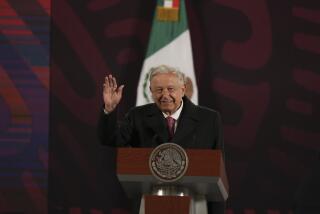An End to the PRI Era--and Way of Life
MEXICO CITY — With their thunderous rejection of the Institutional Revolutionary Party on Sunday, the Mexican people ravaged not only a political party but a way of life.
Opposition challenger Vicente Fox’s presidential victory over Francisco Labastida ended 71 years of unbroken rule by the Institutional Revolutionary Party, or PRI, by far the longest of any governing faction in the world.
But the PRI was far more than just a government. The organization touched nearly every aspect of Mexican life during the 20th century, bringing peace after the brutal Mexican Revolution of 1910-17 and overseeing the country’s transformation into a modern society.
Under the PRI, Mexico changed from an impoverished, rural country dominated by peasants to a mostly urban manufacturing nation, the No. 2 trading partner of the United States.
The party provided Mexico with a political stability unknown in the rest of Latin America, which was frequently shaken by military coups.
It is the only system most Mexicans have ever known.
“I was born under the PRI, I have met seven PRI presidents,” said poet Homero Aridjis, a 60-year-old foe of the ruling party. “I couldn’t believe I would see this in my lifetime. There was such total political control of everything in the country. This makes me recover my confidence in the Mexican people.”
The party’s stewardship foundered in recent years, due to government bungling of the economy that resulted in four successive economic crises at the end of the six-year presidential terms.
In addition, corruption--the grease that lubricated the Mexican machine--became increasingly unacceptable in a more modern society with increasingly free media.
The PRI was founded in 1929 by then-President Plutarco Elias Calles. The party unified an estimated 8,000 squabbling political factions that had emerged from the revolution, during which an estimated 1 million people were killed or died of disease.
Calles’ achievement provided a structure that solved Mexico’s most pressing political problem: how to ensure a transfer of power without bloodshed. The very name of the party combining institutions and the revolution suggested the ingenious system, which involved each sitting president naming his own successor, without bloodshed or turmoil.
Meanwhile the PRI grew far beyond being a political machine. President Lazaro Cardenas, who ruled from 1934 to 1940, built up the party’s sectoral web, which included peasant, worker and business organizations, into a closed system. He also orchestrated a vast land reform program, which distributed parcels to millions of farmers, ensuring their loyalty in return.
PRI offices in small towns and big cities across the country were often adjacent to the town hall. For many, the party and the government were one and the same. From the 1970s on, corruption became an ingrained part of getting things done in Mexico--and synonymous with the PRI.
“The party as touchstone was a powerful enforcer of loyalty to the regime. To stay within the party was to stay in the political game and to retain a chance to serve in the government. To leave the party was to become an outsider,” U.S. historian Dan A. Cothran wrote in his 1994 book, “Political Stability and Democracy in Mexico.”
His study was subtitled “The Perfect Dictatorship?” The question reflects Peruvian writer Mario Vargas Llosa’s description of the PRI--with its vast powers cloaked in democratic processes that included regular elections--as “the perfect dictatorship.”
But prominent Mexican historian Enrique Krauze, in his study of PRI presidents called “Mexico: Biography of Power,” painted a more subtle picture.
“It is neither a dictatorship nor a totalitarian regime,” Krauze wrote. “But neither is it a representative, democratic and federal republic as prescribed in the constitution.”
Yet Krauze noted that the PRI also was unlike the Soviet regime in its respect for civil liberties. Thus there was no widespread terror or intolerance as the system concentrated on perpetuating itself.
That succession process began to collapse in 1988, when a left-wing faction of the PRI broke away and many observers felt that the party won the election only through fraud. In 1994, PRI presidential nominee Luis Donaldo Colosio was assassinated. The party appeared to have lost its footing, although candidate Ernesto Zedillo won handily against a divided opposition.
George Grayson, a U.S. historian, said Sunday that when he first began writing about Mexico in 1976, “families had a grandfather who remembered the revolution, in which 5% of the population died. The specter of change was terrifying. Now the revolution as an event that was carried in the common psyche has disappeared.”
The PRI still holds about two-thirds of the governorships in Mexico and a significant chunk of congressional seats and municipal governments. It is far from a spent force, and already has tried to cast itself as the “new PRI.” The PRI was the only major party to nominate its presidential candidate through an open primary in this year’s election.
What’s more, the PRI has rebounded from defeats before--most notably in Chihuahua state, where Patricio Martinez won the governor’s office back from the National Action Party in 1998. The party is hardly dead, but the loss of the presidency, its defining purpose for much of its life, is a blow of immense proportions.
Poet Aridjis said: “Tomorrow it’s another Mexico for us. Fox is going to represent a new deal for the Mexican people.”
“The PRI made a few social reforms that were very important for the country,” Aridjis conceded. “But the governments became more and more corrupt; they were generating social instability. Corruption was the black hole for Mexican society.”
“I hope the PRI can recover as another party, with another political concept,” he added, “and become a better party in opposition than it is now.”
More to Read
Sign up for Essential California
The most important California stories and recommendations in your inbox every morning.
You may occasionally receive promotional content from the Los Angeles Times.










